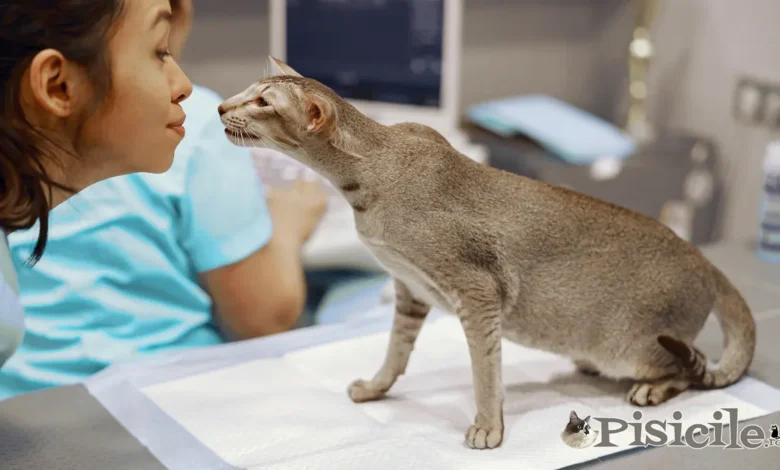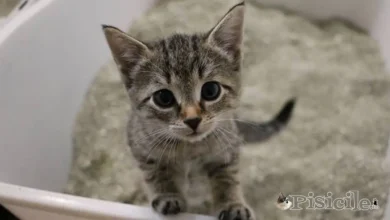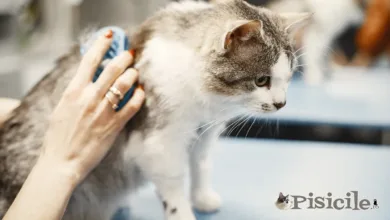
How does it manifest itself, what are the causes and what is ataxia in cats? It's a question asked by many cat owners who notice balance problems in their felines.
Ataxia in cats (feline ataxia) is a neurological condition which affects coordination and balance of the cat. Ataxia is characterized by difficulty controlling movements voluntary movements of the body and limbs, making the animal have a unsteady gait and to have difficulty moving normally.
Subject
Main types of ataxia in cats
There are three types of ataxia in cats, depending on which part of the nervous system is affected.
Cerebellar ataxia
The cerebellum is the part of the brain responsible for coordinating fine movements and balance. Cerebellar ataxia occurs when the cerebellum is affected by injury, genetic disease, or other conditions. Cats with cerebellar ataxia may exhibit unsteady and uncoordinated movements, such as unsteady walking and difficult jumping. They may have difficulty controlling their muscles to make precise movements.
Vestibular ataxia
Vestibular system from the inner ear controls balance and spatial orientation. Vestibular ataxia occurs when this system is affected by infection, inflammation or tumors. Cats with vestibular ataxia may show symptoms such as a tilted or rotating head, unsteady gait, and loss of balance. These symptoms may be accompanied by nausea and vomiting.
Sensory ataxia
This type of ataxia occurs when the sensory nerves or pathways that transmit sensory information are damaged. Cats with sensory ataxia may have difficulty coordinating movements due to decreased sensitivity and sensory feedback. This type of ataxia can be caused by nerve disorders or diseases affecting the peripheral nervous system.
Symptoms – Ataxia in cats
Cats with ataxia may exhibit signs similar to intoxication, such as an unsteady, unsteady gait and an increased tendency to sleepiness. Sometimes the symptoms may be less obvious, such as a slight tilt of the head or a slight curling of the toes when walking.
Among the distinctive signs of ataxia are also count nystagmus, an unusual movement of the eyes that can occur as a result of problems in the central nervous system.
Cats suffering from sudden ataxia may have a tendency to roll or fall to one side and often experience significant nausea from feeling unsteady. On the other hand, if ataxia in cats persists longer, they usually have the ability to adapt over time and are less likely to experience nausea.
Causes – Ataxia in cats
Ataxia in cats can have a variety of causes, including the following:
Brain or central nervous system disorders. Brain tumors, injuries, inflammation, or infection in the cat's brain or spinal cord can lead to ataxia by affecting the proper functioning of the central nervous system.
Cerebellar problems. Damage or malformations of the cerebellum can cause ataxia, as this part of the brain is essential for coordinating movements.
Diseases of the inner ear. The vestibular system in the inner ear plays a crucial role in balance. Infections, inflammation, or injury in this area can cause vestibular ataxia.
Genetic diseases. Certain genetic diseases can cause ataxia, especially when they affect the functioning of the nervous system.
toxicity. Ingestion of toxic substances such as poisonous plants, household chemicals or the wrong medication can trigger ataxia in cats.
Metabolic disorders. Some metabolic conditions, such as hypoglycemia or hereditary metabolic disorders, can influence the normal functioning of the nervous system and cause ataxia.
Infectious diseases. Infections with various microorganisms, such as viruses or bacteria, can affect the nervous system and contribute to the development of ataxia.
Autoimmune diseases. Ataxia in cats can also occur due to autoimmune disorders. These can cause the immune system to attack its own nerve cells, which can lead to neurological symptoms, including ataxia.
Trauma. Blows to the head or spinal cord injuries can affect the functioning of the central nervous system or the cerebellum, leading to ataxia.
Boli degenerative. Some degenerative diseases, such as degenerative intervertebral disc disease, can gradually damage nerve structures and cause symptoms of ataxia.
According to the three main types of ataxia in cats, the causes are as follows:
Cerebellar ataxia
- Congenital malformations of the cerebellum.
- Cerebellar tumors.
- Trauma to the head or spine affecting the cerebellum.
- Brain infections or inflammation affecting the cerebellum.
Vestibular ataxia
- Inner ear infections or inflammation.
- Tumors in the area of the inner ear or the vestibular nerves.
- Damage to the inner ear or the vestibular nerves.
Sensory ataxia
- Disorders of the peripheral nerves responsible for the transmission of sensory information.
- Nerve injuries or compressions.
- Metabolic or genetic diseases that affect the functioning of sensory nerves.
Diagnosis – Ataxia in cats
If you notice signs of ataxia in your cat, it is crucial to take them to the vet immediately. He will perform a thorough medical history and then perform a physical examination of the animal to assess for any neurological abnormalities (affecting the nervous system).
After the type of ataxia (sensory, vestibular, or cerebellar) is identified, additional tests, such as blood tests, a urinalysis, x-rays, and advanced imaging, may be needed to determine the underlying cause. These procedures will help establish an accurate diagnosis and develop an appropriate treatment or management plan for your cat's ataxia.
When ataxia occurs in cats, diagnosis often involves a stepwise and meticulous approach, as symptoms can be similar in several conditions. Here are the usual steps to diagnose ataxia in cats:
Clinical examination. The vet will perform a physical examination of the cat to look for obvious signs of ataxia as well as other associated symptoms.
Medical history. The owner will be interviewed about the observed symptoms, their duration, and any risk factors or recent events that may contribute to the onset of ataxia.
Laboratory examinations. Blood tests and other laboratory tests can help identify possible causes of ataxia, such as infections, metabolic disorders, or electrolyte imbalances.
imagery. Imaging tests, such as computed tomography (CT) or magnetic resonance imaging (MRI), may be used to visualize the brain, spinal cord, and inner ears, identifying possible lesions, tumors, or abnormalities.
Functional tests. The veterinarian may perform tests to assess the coordination and functioning of the cat's nervous system, such as the reflex response test or balance tests.
Exclusion of other conditions. Because the symptoms of ataxia can be similar to those of other diseases, your vet will try to rule out other possible causes, such as poisoning or muscle conditions.
Consult with a specialist. In complex or unclear cases, the veterinarian may recommend consultation with a veterinary neurologist for further evaluation and more advanced interpretation of symptoms and tests.
Treatment – Ataxia in cats
Treatment of ataxia in cats it varies depending on the underlying cause. For example, if the ataxia is the result of an infection, the vet may prescribe specific antibiotics for treatment.
Idiopathic ataxia, or ataxia without a known cause, will be treated with supportive care, including administration of anti-nausea medications. In this situation, the cat will require a safe and protected environment to prevent injury while exhibiting symptoms. In some cases, assisted feeding and intravenous fluids may be necessary if the cat is unable to eat or drink on its own.
Certain types of ataxia can be managed to maintain quality of life, even if they cannot be completely cured. On the other hand, idiopathic ataxia may resolve on its own and may not recur in the future.
In cats affected from birth, it is specific treatment may not be necessary, but their environment must be set up in a safe way to prevent falls or injuries caused by lack of coordination and balance.
Your veterinarian will be able to make a more accurate diagnosis and propose a treatment plan or appropriate management of the condition causing your cat's ataxia.




My motan is 10 years old. He doesn't have a appetite, sometimes I numb his back legs. I was consulting with the veterinarian, he told me he has nothing, I was injection with Vit.B and so on. What to do?